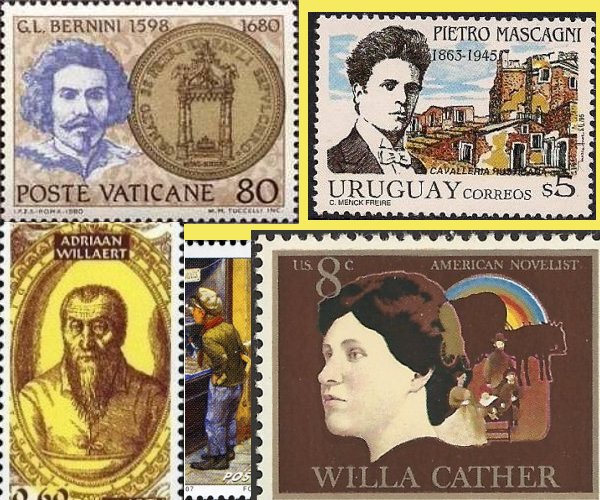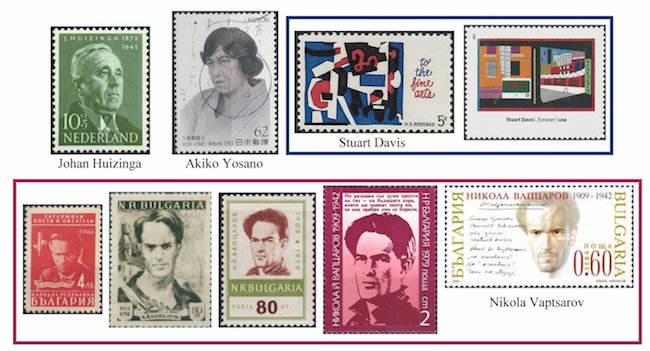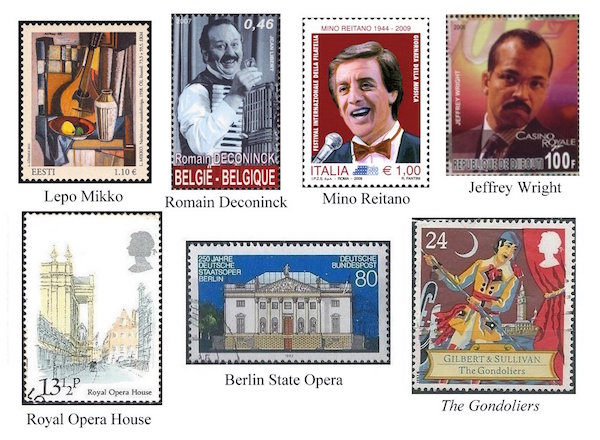The Arts on Stamps of the World — December 7
An Arts Fuse regular feature: the arts on stamps of the world.

By Doug Briscoe
The incredible genius of Gian Lorenzo Bernini (7 December 1598 – 28 November 1680) manifested itself in his creations as a painter, sculptor, and architect—though most of his painting was done in his youth and is overshadowed by his work in the other two fields—and in the theater as a playwright, actor, director, and set designer. Born in Naples to parents from Florence, he was a child prodigy and was brought to Rome, where, aged eight, he made a drawing in the presence of Pope Paul V. Bernini was in Rome to stay. His crowning achievement and most public utterance is the splendid double colonnade of St. Peter’s Basilica, clearly seen in the aerial view of the Square on the Vatican City airmail stamp. Another Vatican stamp shows one of the two fountains (one had been made by Carlo Maderno, who also devised the facade of the basilica, the other was built by Bernini to match it). The Monagasque stamp shows one colonnade along with the massive equestrian statue of Louis XIV Bernini fashioned between 1665 and 1684. (Louis hated it.) Bernini himself is seen on the next stamp, an Italian one marking the tercentenary of Bernini’s death and showing the grand Baldacchino (1623-34) made early in his career for the interior of St. Peter’s. In the second row we see more of the master’s sculpture. A detail from his Ecstasy of Saint Teresa (1651) appears on a stamp of Spain, with an Italian stamp showing the full piece. Next comes another tercentenary stamp offering the early Apollo and Daphne (1622-25). Bernini’s vigorous David (1623-24) is followed by his bust of Costanza Bonarelli (1636-37), the artist’s lover and the source of an ugly story. It seems Bernini had an affair with this young woman, who was the wife of one of his assistants. She turned from Bernini to the arms of his brother Luigi, and Gian Lorenzo flew into a rage and ordered his servant to slash Costanza’s face. The outcome added insult to injury: Bernini was absolved by his patron Pope Urban VIII, and Costanza was jailed for adultery. (The servant was imprisoned, too.) An appalling blot on the life of a great artist. It is said that Bernini was repentant and led a holy life thereafter. That’s nice. In the bottom row are the two sculptures Bernini made for the Ponte Sant’Angelo and a view of the bridge entire. Pope Clement IX commissioned a set of ten angels, but Bernini and his son completed only two, and those ended up in the Pope’s collection, with substitutes created for the bridge. The Angel with the Crown of Thorns and Angel with the Superscription (or Scroll) are now housed at the church of Sant’Andrea delle Fratte.
The sole stamp for wonderful Willa Cather (December 7, 1873 – April 24, 1947) completes today’s first collage. Given the subject matter of the core of Cather’s output we tend to think of her as Nebraska-born and forget she was actually born in Virginia and lived there until she was nine. She was in Pittsburgh from 1896 to 1906, contributing pieces to periodicals, then, after the publication of her first set of short stories, The Troll Garden, she moved to New York. Her first novel, Alexander’s Bridge (1912), was followed by the magnificent Prairie Trilogy: O Pioneers! (1913), The Song of the Lark (1915), and My Ántonia (1918). These were admired by such critics as H. L. Mencken, Sinclair Lewis, and Carl Van Doren. In 1922, Cather won the Pulitzer Prize for her beautiful novel One of Ours. Incidentally, The Song of the Lark tells the story of an aspiring opera singer, and O Pioneers! was made into an opera by American composer Tyler Goodrich White; it was completed and first performed in 1999 in Nebraska.

Music is the concern of our next subject, Netherlandish composer Adrian Willaert (VIL-art), born around 1490 in West Flanders. He went to Paris and Rome, where he was surprised to hear one of his own compositions being performed in the papal chapel. He served the d’Este family in Hungary, Ferrara, and Milan before being named maestro di cappella at St. Mark’s in Venice, a post he held for 35 years until his death on 7 December 1562. He was one of the most important and influential composers of his time.
The striking accomplishments of Swedish architect Nicodemous Tessin the Elder (1615 – 24 May 1681) may have been relegated to second tier today only because he was born on the same day as Bernini. Tessin was responsible, however, for the grand palace of Drottningholm, the Swedish royal residence. The new building replaced one that had burned down at the end of 1661. Work began on the replacement the next year but was not completed until well after Tessin’s death. His son (guess what his name was) finished it in 1700. Tessin was born in Pomerania and came to Sweden in his youth to work for Axel Oxenstierna. He undertook further studies in Western Europe before returning to embark on his string of palaces. The primary architect for Skokloster Castle (next stamp over) was actually Caspar Vogel, but Tessin was also involved in this project, which took from 1654 to 1676 to complete. It lies between Stockholm and Uppsala. Ulriksdal Palace, on the 50 kronor stamp, was another renovation of an older building, lying some 6 kilometers north of Stockholm. The same is true, finally, of Strömsholm Palace, situated on the location of an older palace from the 1550s and updated in 1669-74.

Today is the 400th anniversary of the birth of Italian painter Evaristo Baschenis (December 7, 1617 – March 16, 1677), who is represented on a single stamp (from Umm al Qiwain) with his Still Life of Musical Instruments (1650). He was born into a family of artists in Bergamo. It seems musical instruments commonly feature in his still lifes, possibly because he was friendly with a family of violin makers from Cremona.
Johann Nestroy (7 December 1801 – 25 May 1862) was an Austrian singer, actor, and playwright who began his career singing Sarastro in The Magic Flute on 24 August 1822 in his native Vienna. A year later he move on to Amsterdam and from 1825 to 1831 returned to Austria to perform baritone roles in various cities. Back in Vienna he continued singing but took up his pen and had a great success with his first effort, Der böse Geist Lumpazivagabundus (The Naughty Ghost Lumpazivagabundus, 1833). As you might guess from that title, Nestroy tended to comedy, with an emphasis on parody, and had to tread a careful path to avoid offending the sensibilities of Metternich’s minions. He excelled at wordplay and almost always incorporated songs into his plays. Over a twenty-year span he composed some eighty comedies. With one exception, these are not well known in the US, but Einen Jux will er sich machen (He’ll Go On a Spree, 1842) was adapted by Thornton Wilder as The Matchmaker in 1955, and that in turn was developed into the hit musical Hello, Dolly! (1964). This same play (Einen Jux) was translated by Tom Stoppard in 1981 and given the title On the Razzle.
The Urdu poet Mir Baber Ali Anees (or Anis) came from what is now the state of Uttar Pradesh in northern India. Sources differ as to the dates of his birth and death, with the Azerbaijani version of Wikipedia (no, I don’t read Azerbaijani) claiming December 27, 1802 as his date of birth. All other sources I consulted simply state the year 1802. English Wiki says he died on this date in 1874, and Ukrainian gives December 10. In any case, we salute this multilingual writer who came of a family of poets going back five generations. His work is primarily religious, and he is credited with thousands of verses. Though writing mainly in Urdu, Anees used many Persian, Hindi, Arabic, and Sanskrit words in his poems.

Born in the northern Serbian village of Orlovat, Uroš Predić (December 1857 – 12 February 1953) trained in Vienna, an 1880 graduate of the Academy of Fine Arts. He stayed on in the city to take up teaching, and worked under architect Theodphil Hansen, painting murals for the Imperial Council Building (now the Austrian Parliament Building). Predić returned to his village in 1885, painting genre pictures of his neighbors. He lived in various Serbian cities thereafter, had his first show in Belgrade in 1888, and took part in the 1889 Paris Exhibition. We see his Self-Portrait on a stamp from Yugoslavia and Boy in Front of a Shop Window (1878) on a 2007 Serbian stamp.
Italian opera composer Pietro Mascagni (7 December 1863 – 2 August 1945) is usually thought of as a “one-hit wonder”, his 1890 Cavalleria Rusticana (Rustic Chivalry) being easily the best-known of his works. But at least two of his other operas, L’amico Fritz (1891) and Iris (1898), remain in the repertoire in Italy and elsewhere in Europe. The Italian stamp is a centennial offering from 1963, and the one from Uruguay marks the sesquicentennial in 1995 of the composer’s death.
We make passing mention of the Dutch cultural historian Johan Huizinga (December 7, 1872 – February 1, 1945). He was the author of the important The Waning of the Middle Ages (1919), subtitled “A study of the forms of life, thought and art in France and the Netherlands in the fourteenth and fifteenth centuries”, as well as a biography of Erasmus (1924) and other works.
The remarkable Japanese poet Akiko Yosano (7 December 1878 – 29 May 1942) was a forerunner of feminism, pacifism, and social reform in Japan. Born Shō Hō to a well-to-do merchant family, she read extensively and began contributing to a poetry magazine while still in high school. She married the editor, Tekkan Yosano, in 1901. Her first book, a volume of 400 tanka poems, was attacked by critics but widely appreciated by general readers for its individualism and feminist viewpoint. In the years to come show would produce a further twenty volumes of tanka poetry. Curiously, Yosano sharply criticized the Russo-Japanese War and the military in general, but became an ardent supporter of Japanese Imperialism during the Second World War.
American modernist painter Stuart Davis (December 7, 1892 – June 24, 1964) is up next. He, too, used his art as a means of social change. Born in Philadelphia, Davis was the child of an art editor and a sculptor. He studied under under Ashcan School leader Robert Henri and took part in the 1913 Armory Show. He used to spend his summers painting in Gloucester. A jazz aficionado, Davis may have emulated improvisation in his series of similar works with subtle variants. The stamp from a 2013 sheet shows House and Street (1931).
Bulgarian poet Nikola Vaptsarov (7 December 1909 – 23 July 1942) is no doubt remembered on stamps more for his revolutionary activities and antifascist resistance during World War II, activities for which he lost his life and became a martyr for the Communist cause. (It didn’t hurt that he was handsome.) All the same, he is highly regarded as a poet despite having published only a single volume of verse, Motor Songs (1940). Vaptsarov worked as a machinist, writing in his spare time and organizing amateur theatricals. His poems did gain notice from their publication in newspapers, and one of them won a poetry contest. Becoming ever more deeply involved in political action, he was arrested for arranging supplies of guns and documents for the resistance and executed by firing squad.
A work by the Estonian painter Lepo Mikko (1911 – 6 December 1978), Still Life with Mandolin, can be seen on the stamp from 2012. It’s illustrative of the fact that Mikko often put musical instruments into his work, which also consists of landscapes and figurative compositions. His art education had to be suspended for several years for lack of funds. He worked at odd jobs, including painting and photography, until he could resume his studies in 1936. World War II prevented a planned visit to Paris. His career was thus largely restricted to his homeland.
We have next two popular entertainers from Europe. Belgian stage actor, singer, writer, and director Romain Deconinck (1915 – 1 December 1994) is credited with the writing of 140 comedies. He branched out into film (mainly as a comic actor) and television (mainly as a director). The stamp comes from 2007.

Italian singer, songwriter, and actor Mino Reitano (December 7, 1944 – January 27, 2009) was born near Reggio Calabria and studied at the music conservatory there, learning piano, trumpet, and violin. He and his brothers performed together in a band, taking their act on tour to Germany. He had success both as a singer and as a songwriter for other artists. His later work was often directed to a children’s audience.
The fine American actor Jeffrey Wright turns 52 today (born December 7, 1965). He first came to national attention with his brilliant performance in HBO’s Angels in America. (He had played the part on Broadway and won a Tony for it.) Subsequently Wright caused a stir with his portrayal of the title character in Basquiat (1996), then went on to popular success playing CIA agent Felix Leiter in two James Bond movies (one of which, Casino Royale, is subject of the stamp sheet from Djibouti). Wright was unforgettable as Dr. Narcisse in HBO’s Boardwalk Empire, but I’m sorry to note that he has taken part, with a number of other fine actors who should know better, in the wretched Hunger Games trash. Right now he’s appearing in the more interesting scenes from the current HBO series Westworld. Wright was born in Washington, D.C. In 2011, he founded Taia Lion Resources, “a mineral exploration company” based in Sierra Leone that is devoted to “ethical and sustainable” mining practices in bringing wealth to the impoverished nation.
London’s Royal Opera House opened as the Covent Garden Theatre on this date in 1732 with a performance of Congreve’s play The Way of the World. For its first century, the house was mostly devoted to drama, although a ballet was given there in 1734, and in that year Handel, having been named musical director, began his association with a presentation of his Il pastor fido. Fires claimed the first building in 1808 and the second in 1856. Today’s facade, along with the foyer and auditorium, dates from 1858; the rest was reconstructed in the 1990s.
Originally known as the Court Opera (Hofoper), the Berlin State Opera (aka Deutsche Staatsoper and Staatsoper Unter den Linden) opened to the public on December 7, 1742 with a performance of Carl Heinrich Graun’s Cesare e Cleopatra, even though the building was not quite finished. A century later (August 18, 1843) the house was destroyed in a fire, and a century after that (1941) the Lindenoper fell victim to Allied bombing. It reopened later that year but was bombed again on February 3, 1945. Then it didn’t reopen until 1955. The new building is depicted on the stamp, issued in 1992 for the 250th anniversary of the founding. Over the course of its history, the Berlin Opera has given the premières of Weber‘s Der Freischütz, Nicolai’s Merry Wives of Windsor, and Berg‘s Wozzeck.
Speaking of premières, today marks the 128th anniversary of the first performance of The Gondoliers at the Savoy Theatre in 1889. It was Gilbert and Sullivan’s twelfth collaboration and ran for 554 performances.
Honorable mentions (i.e., no stamps) for today go to Joyce Cary (7 December 1888 – 29 March 1957), Noam Chomsky (born December 7, 1928), and Tom Waits (1949).
A graduate of the University of Massachusetts with a B.A. in English, Doug Briscoe worked in Boston classical music radio, at WCRB, WGBH, and WBUR, for about 25 years, beginning in 1977. He has the curious distinction of having succeeded Robert J. Lurtsema twice, first as host of WGBH’s weekday morning classical music program in 1993, then as host of the weekend program when Robert J.’s health failed in 2000. Doug also wrote liner notes for several of the late Gunther Schuller’s GM Recordings releases as well as program notes for the Boston Classical Orchestra. For the past few years he’s been posting a Facebook “blog” of classical music on stamps of the world, which has now been expanded to encompass all the arts for The Arts Fuse.
